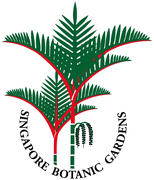Porana
Accepted name/Authority/Place of publication:
Porana Burm.f., Fl. Ind. 51. t. 21*. 1768.
Tribe:
Poraneae
Type Species:
Porana volubilis Burm. f.
Habit:
Lianas; stems subglabrous, lenticellate. Roots fibrous.
Leaves:
Leaves simple, entire, chartaceous; venation pinnate, veins prominent underneath; petiole sulcate (grooved lengthwise).
Inflorescences:
Inflorescence thyrsiform: an axillary (or terminal), bracteose, compound panicle; bracts foliaceous and petiolate, diminishing distally and becoming sessile; bracteoles 2, scale-like, borne at peduncle/pedicel junction; anthesis proceeding acropetally.
Flowers:
Flowers small, fragrant. Sepals 5, free, quincuncial, outer ones half as long as corolla, equally or unequally accrescent in fruit. Corolla campanulate or broadly funnelform-campanulate, 5-lobed, lobes plicate and valvate (not twisted), interplicae hairy outside, plicae diaphanous, glabrous. Stamens 5, unequal, longest 2 or 3 exserted, filaments fused below to corolla tube, free above, glabrous; anthers ellipsoid, longitudinally dehiscing prior to anthesis; pollen 3-colpate, nonspinose. Pistil exserted; disc annular; ovary unilocular or incompletely bilocular; ovules 4, basal, erect; style terminal, unequally 2-branched; stigmas 2, reniform.
Pollen:
Pollen 3-colpate, nonspinose.
Fruits:
Fruit a brittle chartaceous utricle, wall breaking irregularly or tardily splitting along suture in acropetal direction, protruding from chartaceous, papery calyx, outer 3 or all 5 sepals greatly enlarged, 7–9-veined; veins longitudinal, forming a subapical reticulum, veins ± prominulous.
Seeds:
Seed 1 (rarely 2), scurfy at first, smooth later, glabrous; hilum basal, C-shaped.
Distribution:
Southeast Asia, Malesia and Mexico. map
Countries:
Mexico
Thailand
Malaysia
Number of Species:
2
Other information:
As defined here, Porana consists of just two species, one from Southeast Asia and Malesia, and the other from Mexico. The morphological characters diagnostic for Porana are: lenticellate stems; pinnate leaf venation; a large calyx that covers much of the corolla; a campanulate or broadly funnelform-campanulate corolla; a 2-branched style; fruiting calyx with outer 3 or all 5 sepals ± equally enlarged; and the looping, weakly developed longitudinal veins of the fruiting sepals. Recent molecular studies support this generic concept (Stefanovic et al. 2002).
References:
G. Staples & D. Austin. 2009. Edinburgh Journal of Botany 66: 133-153.
Ooststroom, S.J. van. 1938. Blumea 3: 85.
Ooststroom, S.J. van. 1953. Fl. Males. ser. I, 4: 402.
Kerr, A.F.G. 1951. Fl. Siam. Enum. 3(1): 91–93.
R.C. Fang & S.H. Huang. 1979. Fl. Reip. Pop. Sin. 64(1): 24.
G. Staples. 2006. Blumea 51: 455.
Contributors:


The generic concept adopted for Porana here is the narrowest since the late eighteenth century. Wight (1843) recognized that the generic concept of Porana, based on P. volubilis, was very close to that for Bonamia Thouars, due principally to similarities in vegetative and floral characters. However, Myint & Ward (1968) made no mention of the similarities between P. volubilis and Bonamia in their revision of the latter genus. The fruits, long thought to be diagnostic (septicidal capsules in Bonamia and indehiscent or irregularly fragmenting utricles in Porana) are not so distinctive as once thought. Field observation of some Mexican Bonamia spp. revealed that their fruits break open irregularly (A. McDonald, pers. comm. 1987). And the suture in the fruit of P. volubilis sometimes first splits apart near the base and the fruit later shatters irregularly. The accrescent calyx of Porana immediately sets this genus apart from Bonamia, which has persistent but nonaccrescent calyces. Clearly the relationship between Porana s.s., and Bonamia bears further investigation.